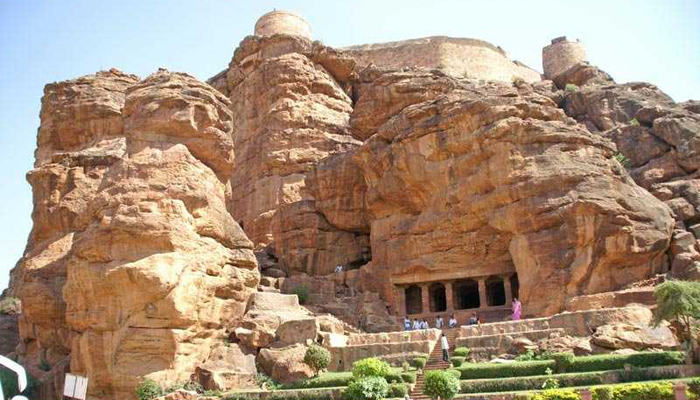Badami is truly famous for its Cave Temples that date back to the 6th and 7th centuries. Located at Badami in Bagalkot district of Karnataka, Cave Temples represent the fine architectural style of the ancient times. The nearest airport to Badami is located in Belgaum. Belgaum lies at a distance of 150 kms from Badami and one can easily reach the cave temples by hiring taxis. Various tourist buses and coaches are also available throughout the state of Karnataka. Badami is sited at the orifice of a gorge that is fringed by two rocky hills.
Architecture
Badami is acknowledged for being the ancient kingdom of Chalukyas. In the 6th century, Badami was established by Pulakesin I; however the architectural expansion was observed by the Chalukyas. The sect constructed numerous temples and monuments, marking the instigation of the Hindu architectural style. Badami Cave Temple is the best example of Chalukyan style of architecture. Made out of Sandstone hills, Badami Cave Temples boast of rock-cut architecture.
In totality, there are four cave temples in Badami. All these temples enclose brilliant carvings with the sculptures of Gods from the Hindu pantheon. The structure of these temples is a perfect fusion of North Indian Nagara style and South Indian Dravidian style of architecture. Each cave embraces a sanctum, a hall, a verandah and pillars. Beautiful carvings and exquisite sculptures adore the site of Cave Temples. At the cutting edge, one can see a reservoir that makes a perfect foreground to these architectural structures.
Caves Temples
The first and the foremost cave is known to be built in 578 A.D. One can reach the cave by taking a flight of 40 steps. Dedicated to Lord Shiva, the cave adorns not less than 81 sculptures of Lord Shiva in the form of 'Nataraj' having 18 arms. Made out in Red sandstone, the cave has an open verandah, a hall with numerous columns and a sanctum. The ceilings and pillars are festooned with paintings of amorous couples.
The second cave can be sited at the summit of a sandstone hill. This Cave Temple is dedicated to Lord Vishnu, the preserver of the Universe as per the Hindu beliefs. Here, Lord Vishnu is presented in the form of a 'Trivikrama' (dwarf) where his one foot is commanding the Earth and with the other he is mastering the sky.
Perched on the hill, the third Cave Temple traces its origin in 578 A.D. The front elevation of the cave is approximately 70 ft wide. The platform is carved with the images of 'ganas'. The structure of the temple rejuvenates the memoirs of Deccan style of architecture. This temple is a fine example of the artistic quality and sculptural genius. The sculpture of Lord Vishnu in the company of a serpent captures the major attention. Here, Lord Vishnu is represented in his various incarnations including Narsimha, Varaha, Harihara (Shiva-Vishnu) and Trivikarma.
The fourth Cave Temple is accredited for being dedicated to the Lord Mahavira, the 24th Tirthankara of the Jains. The cave is believed to be the latest amongst all the four caves. It finds its origin in the 7th century, near about 100 years after the construction of earlier three caves. In this shrine, one can see the image of Lord Mahavira in a sitting posture.
The artistic quality and sculptural grandeur mark the very sight of these cave temples at Badami. The rich traditions of India are depicted through these monuments of heritage. People from all over the World come to visit these shrines of architectural radiance and religious significance.
Location : In Badami, Bagalkot District, Karnataka
Built in : During 6th and 7th centuries
Dedicated to : Lord Shiva, Lord Vishnu and Lord Mahavira
Attraction : Exquisite carvings and sculptures

